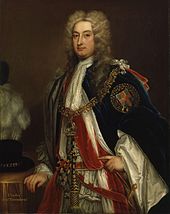John Deane (sailor)
The many accounts of his life include that of William Henry Giles Kingston,[1] who confirms that Deane "really existed", and Richard H.
[1][5] Deane's early upbringing was in relative poverty, working as an apprentice to a butcher and drover around Nottingham and London.
[5] Deane was described by 19th-century writer W. H. G. Kingston as a Royal Navy officer,[6] who rose to the rank of captain and led in the Capture of Gibraltar at the height of the War of the Spanish Succession before becoming a merchant sailor in about 1709.
[8][9] At around 9:00 pm on 11 December Deane's ship struck a rock outcrop on Boon Island, approximately eleven kilometres off York, Maine.
[3] The entire crew made it ashore on Boon Island, but the cargo and galley were wrecked and lost to the sea.
Residents on the shore nearby found one of the washed-up bodies and sent a team to Boon Island the following day to rescue the remaining survivors.
He was soon court-martialled and, although eleven officers and under-officers from his crew testified in support of him, was found guilty and was dismissed from service with a year in prison.
[11] Following the Treaty of Nystadt, ending the Great Northern War in 1721, Deane was dismissed from the Russian Navy and formally expelled from the country with the warning to "never return to Russia".
Deane also produced "The Present State of the Maritime Power of Russia" which gave explicit detail on the Baltic Fleet.
[5] Deane's work at the Port of Ostend was greatly valued by the British Government with the arrangement of a good annual salary of £200 with expenses.
[7] He was noted for his effective suppression of the Ostend Company, the first attempt by the Holy Roman Empire to monopolise trade with the East Indies.
[6][7] Following his departure from the Russian Navy in 1725, Deane had constructed two large Georgian houses in the village of Wilford, south of Nottingham.
He frequently visited his Wilford home sometimes for several months at a time whilst employed as Consul of the Port of Ostend and retired to there in 1736.
[7] Deane died in 1762 at the age of eighty-three following a violent assault and robbery whilst walking in fields near his house; his assailant was later hanged for his crime.






